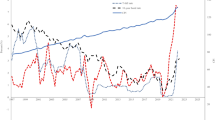Abstract
A remarkable feature of the Argentinean economy is the widespread use of the US dollar as a measure of value, storage of value and in several high-end markets, as a medium of exchange. The use of this currency for these roles has been adopted by all the income strata in the country. Economists explain this, in what we call the rational narrative, as a rational response to the many uncertainties affecting the economy. On the other hand, sociologists and other social scientists have attributed this fact to a “cultural” bias. The latter is what we call the sociological narrative. These two conflicting narratives dominate the discussion on economic policies, particularly when the country enters in one if its frequent crises. In this paper we assess which of these two narratives is better supported by real-world data. For this, we use as a proxy for the interest in the US dollar the Internet searches for its value on the black market. The idea is that according to the sociological narrative, the interest in the value of the dollar precedes any actual change in the price of the American currency. On the other hand, an implication of the rational narrative is that increases in the value of the dollar (the usual variation in inflation-ridden Argentina) creates incentives to look for convenient purchasing opportunities. Thus, according to the rational narrative, searches should come after changes in the value of the dollar. We run several statistical analyses and find that the actual purchases of dollars precede Internet searches, allowing us to reject the sociological narrative.


Similar content being viewed by others
References
Akerlof, G.A., Shiller, R.J.: Phishing for Phools. The Economics of Manipulation and Deception. Princeton University Press, Princeton (2015)
Antolini, F., Grassini, L.: Foreign arrivals nowcasting in italy with google trends data. Qual. & Quant. 53(5), 2385–2401 (2019)
Banco Central de la República Argentina: La reversión de la dolarización es económica y cultural (2020). http://www.bcra.gov.ar/noticias/pesce-reversion-de-la-dolarizacion-es-economica-y-cultural.asp Accessed 2021-06-22
Bénabou, R., Falk, A., Tirole, J.: Narratives, imperatives, and moral reasoning. Natl. Bur. Econ. Res. (2018). https://doi.org/10.3386/w24798
Bertsch, C., Hull, I., Zhang, X.: Narrative fragmentation and the business cycle. Econ. Lett. 201, 109783 (2021). https://doi.org/10.1016/j.econlet.2021.109783
Burdisso, T., Corso, E.A., et al.: Uncertainty and portfolio dollarization. The argentine case in the last half century. Ensayos Econ. 1(63), 41–95 (2011)
Chen, Y., Yan, F.: Economic performance and public concerns about social class in twentieth-century books. Soc. Sci. Res. 59, 37–51 (2016)
Chen, Y., Yan, F.: International visibility as determinants of foreign direct investment: An empirical study of chinese provinces. Soc. Sci. Res. 76, 23–39 (2018)
Choi, H., Varian, H.: Predicting the present with google trends. Econ. Rec. 88(Suppl.Suppl.1), 2–9 (2012). https://doi.org/10.1111/j.1475-4932.2012.00809.x
Corso, E.A., et al.: Ambiguity, ambiguity aversion and reserve of value in argentina. Ensayos Econ. 1(73), 91–115 (2015)
DellaVigna, S., La Ferrara, E.: Economic and social impacts of the media. In: Handbook of Media Economics, vol. 1, pp. 723–768. Elsevier, Amsterdam (2015). https://doi.org/10.1016/B978-0-444-63685-0.00019-X
Dickey, D.A., Fuller, W.A.: Distribution of the estimators for autoregressive time series with a unit root. J. Am. Stat. Assoc. 74(366a), 427–431 (1979)
Glazer, J., Rubinstein, A.: Story builders. J. Econ. Theory 193, 105211 (2021). https://doi.org/10.1016/j.jet.2021.105211
Gregory, A.W., Hansen, B.E.: Practitioners corner: tests for cointegration in models with regime and trend shifts. Oxf. Bull. Econ. Stat. 58(3), 555–560 (1996)
Herzenstein, M., Sonenshein, S., Dholakia, U.M.: Tell me a good story and i may lend you money: the role of narratives in peer-to-peer lending decisions. J. Mark. Res. https://doi.org/10.1509/jmkr.48.SPL.S138
Hodrick, R. J., Prescott, E.C.: Postwar US business cycles: an empirical investigation. J. Money. Credit. Bank. 29(1), 1–16 (1997). https://doi.org/10.2307/2953682
Kahneman, D.: Maps of bounded rationality: psychology for behavioral economics. Am. Econ. Rev. 93(5), 1449–1475 (2003). https://doi.org/10.1257/000282803322655392
Kripfganz, S., Schneider, D.C.: Ardl: Stata module to perform autoregressive distributed lag model estimation. Proceedings of the 2016 Chicago Stata Conference (2016)
Luzzi, M. (2013). Economía y cultura en las interpretaciones sobre los usos del dólar en la Argentina. Sociales en debate, (5). (2013). Recovered from https://publicaciones.sociales.uba.ar/index.php/socialesendebate/article/view/3319
Luzzi, M., Wilkis, A.: Soybean, bricks, dollars, and the reality of money: Multiple monies during currency exchange restrictions in Argentina (2011–15). HAU J. Ethnogr. Theory 8(1–2), 252–264 (2018). https://doi.org/10.1086/698222
Luzzi, M., Wilkis, A.: El Dólar: Historia de Una Moneda Argentina, 1st edn., p. 334. Crítica, Ciudad Autónoma de Buenos Aires (2019)
Massicotte, P., Eddelbuettel, D.: gtrendsr: Perform and display google trends queries. R package version 1(2),(2018).
Newey, W.K., West, K.D.: A simple, positive semi-definite, heteroskedasticity and autocorrelationconsistent covariance matrix. Mass, USA, National Bureau of Economic Research Cambridge (1986)
Nyman, R., Kapadia, S., Tuckett, D.: News and narratives in financial systems: exploiting big data for systemic risk assessment. J. Econ. Dyn. Control 127, 104119 (2021). https://doi.org/10.1016/j.jedc.2021.104119
Pesaran, M.H., Shin, Y., Smith, R.J.: Bounds testing approaches to the analysis of level relationships. J. Appl. Econ. 16(3), 289–326 (2001). https://doi.org/10.1002/jae.616
Shiller, R.J.: Narrative economics. Am. Econ. Rev. 107(4), 967–1004 (2017). https://doi.org/10.1257/aer.107.4.967
Shiller, R.J.: Narrative Economics, 1st edn. Princeton University Press, Princeton (2020)
Sotis, C.: How do google searches for symptoms, news and unemployment interact during covid-19? a lotka-volterra analysis of google trends data. Qual. & Quant. pp. 1–16 (2021)
Tubadji, A., Boy, F., Webber, D.: Narrative economics, public policy and mental health. Cent. Econ. Policy Res. 20, 109–131 (2020)
Wanner, P.: How well can we estimate immigration trends using google data? Qual. & Quant. pp. 1–22,(2020)
Wooldridge, J.M.: Introductory Econometrics: A Modern Approach. Cengage learning, Boston (2015)
Zelizer, V.A.: The Social Meaning of Money: Pin Money, Paychecks, Poor Relief, and Other Currencies. Princeton University Press, Princeton (2017)
Author information
Authors and Affiliations
Corresponding author
Additional information
Publisher's Note
Springer Nature remains neutral with regard to jurisdictional claims in published maps and institutional affiliations.
Rights and permissions
About this article
Cite this article
Delbianco, F., Fioriti, A., Tohmé, F. et al. A Tale of two narratives: assessing the sociological hypothesis of the appeal of the US dollar in Argentina. Qual Quant 56, 3519–3537 (2022). https://doi.org/10.1007/s11135-021-01280-x
Accepted:
Published:
Issue Date:
DOI: https://doi.org/10.1007/s11135-021-01280-x




